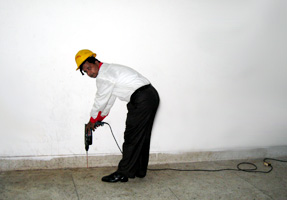What is a termite infestation?
Termites are social insects, meaning that they live in colonies. When termites from a colony or part of a colony are present in a structure, the structure is said to be infested. To survive, subterranean termites will need a moisture source, which they obtain by going back to the ground, bringing moisture with them, or by using moisture found in the structure due to leaks, condensation or lack of ventilation. Drywood termites do not need additional moisture and will attack sound wood. Drywood termites are found mostly in southern Florida, southern California and Hawaii. Subterranean termites are found in virtually all states except Alaska.
How does an infestation occur?
Termites, as with all living creatures, need food. Cellulose found in wood is the food source for most termites found in North America. They feed on cellulose-based material like wood, books, boxes, furniture and drywall coverings. Termites are constantly foraging and have been found over 150 feet from a colony. Infestations can occur two ways. First, healthy colonies send out winged reproductives to start new colonies. When termites find a suitable area, they will start a new colony. The second way that infestations occur is if subterranean termites are foraging for food and they find their way into a structure. Subterranean termites can do this by building mud tunnels over foundations to provide themselves access to the wood of the structure.
First, healthy colonies send out winged reproductives to start new colonies. When termites find a suitable area, they will start a new colony. The second way that infestations occur is if subterranean termites are foraging for food and they find their way into a structure. Subterranean termites can do this by building mud tunnels over foundations to provide themselves access to the wood of the structure.
What are the telltale signs of infestation?
Telltale signs of infestation will vary by type of termite. For drywood termites, found generally in subtropical areas, homeowners might notice pellets or termite droppings. These are small, ridged, wood-colored pellets. They might fall from the ceiling or from furniture. For subterranean termites, a swarm of winged termites emerging within a structure is a sign that an infestation is nearby. As subterranean termites build mud tubes to enter a building, these straw-like tubes from the structure to the ground indicate an infestation, past or present. For the imported Formosan termite, “carton” or mud structures within a wall indicate an infestation. It is best to have a professional pest control inspector look at a potential infestation to determine if it is a termite issue and whether it is active.
Why are termites a threat to my home?
Termite colonies work 24 hours a day, and signs of termite infestations can go undiscovered until serious damage is done. Because homeowners insurance typically does not cover termite damage, termite detection and continued termite treatment are the best ways to help protect your property.
According to industry statistics, termites cause over $5 billion in documented damage each year. It is likely that the number is actually higher than that. However, homeowners insurance routinely excludes termite damage, so insurance will not pay for treatment or repairs. Most people list their homes as their single largest investment, and termite infestation and damage can be devastating. Termites in a commercial building have the same effect; it is an uninsured event which must be addressed.
Termite Control
 Comments:
Comments:








